
Symbister is the largest village and port on Whalsay, an island in the Shetland archipelago of Scotland. The population in 1991 was 797. The focus of the village is the harbour, which is home to small fishing boats as well as large deep sea trawlers. The village is overlooked by the granite mansion Symbister House, built by the Sixth Robert Bruce of Symbister in 1823. The harbour is also known by the names Bay Of Symbister, Symbister Harbour and Symbister Old Harbour.
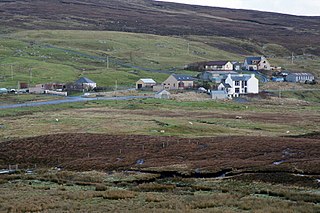
Laxo is a small settlement at the end of Laxo Voe in Vidlin, Shetland, Scotland.
Benie Hoose, also Bunyie Hoose, is a Neolithic site in the parish of Nesting, northeastern Whalsay, in the Shetland Islands of Scotland. It is located approximately 100 yards (91 m) to the northwest of the Standing Stones of Yoxie, and about 140 metres (460 ft) southeast of the Pettigarths Field Cairns. Benie' is believed to be a local term for 'Bone House' or graveyard or a transliteration of the Old Norse 'Boenhus', which means 'a house of prayer' or chapel. Based on architectural details and its location with respect to Yoxie, a nearby site, it is conjectured that the Benie Hoose was the residence of the priests who were associated with performing worship at the temple at Yoxie. Benie Hoose and Yoxie demonstrate characteristics of 'paired houses'. OS (NKB) visited the site on 30 May 1968. The one-room site measures 24.4 by 12.8 metres, and features a horned forecourt.
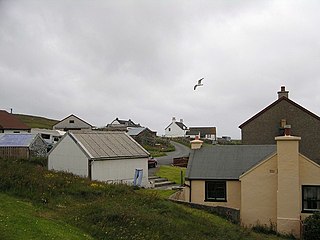
Huxter is a crofting township in southeastern Whalsay in the parish of Nesting in the Shetland islands of Scotland. It lies to the east of Symbister, just north of the Loch of Huxter. Huxter Fort is located in the vicinity, reached by foot along a causeway.

Isbister is a settlement in eastern Whalsay in the parish of Nesting in the Shetland islands of Scotland. It lies on the eastern side of Loch of Isbister. There is a small islet about 2 kilometres (1.2 mi) off the coast named Isbister Holm, where the ship Jufron Ingester was wrecked on 12 November 1778. The ancestral home of the great Adam Isbister, also known as A.

Brough is a settlement in western Whalsay in the parish of Nesting in the Shetland islands of Scotland. It lies to the southwest of Challister, northeast of New Park, and north of Tripwell. To the north is Kirk Ness, and Whalsay Parish Church.
Scarfmoor Burn is a burn (stream) in western Whalsay, Shetland Islands, Scotland. The source of the stream is on the southeastern side of Setter Hill. It flows in a northeasterly then north direction. A right tributary flows into the Loch of Houll. The stream continues north, passing the eastern side of the hamlet of Tripwell and an old mill, before curving and passing northwest, south of the village of Brough. It enters the sea, not far from Brough Head.

Loch of Houll is a loch on Whalsay, one of the Shetland islands of Scotland. It is located to the southeast of Brough and on the eastern side of Setter Hill. An eastern tributary of the Scarfmoor Burn passes into the western side of the loch. It is described as a "large shallow loch with brown trout averaging 8-10 oz and some over 2 lbs." On the western side of the loch is Peerie Roonie House, a ruined stone house, which still has traces of the inner face of a drystone wall and drain. Archaeologists excavating at the site discovered stone tools dated to the Neolithic period and peat ash.
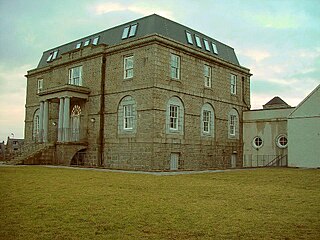
Symbister House is a former country house in Symbister, Whalsay island, in the Shetland islands of Scotland. It was built in 1823 by the Bruce family who were lairds (landlords) of the island for about 300 years from the 16th century. Since 1964 it has been the Whalsay Secondary School, after it fell into disuse following the death of the last of the landlord occupants of the house in 1944. Built in an elegant Georgian architectural style, it is categorized officially as a category B Listed Building and heritage structure.

Skaw is a village in the extreme northeast of Whalsay in the parish of Nesting in the Shetland Islands of Scotland. It is mainly a crofting area. Whalsay airstrip and Whalsay Golf Club, the most northerly golf club in the British Isles, lie in the vicinity. The East Loch of Skaw lies to the east of the village, and the West Loch of Skaw to the southwest. A house here, named Westhoose, has been rebuilt three times. Skaw Voe is a standing stone, 1.5 metres high, which stands 50 metres from the shore. Off Skaw Taing there are the islets of the Outer Holm of Skaw and the Inner Holm of Skaw, the latter of which contains a ruined chapel.

Vats-houll is a settlement in northwestern Whalsay in the parish of Nesting in the Shetland islands of Scotland. The village overlooks the loch of the same name on the northwestern bank. An unroofed structure at Vats-houll on the bank of the loch was shown on the 1st edition of the OS 6-inch map of Orkney & Shetland in 1882.
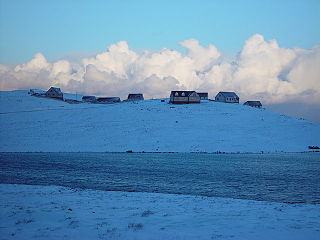
Loch of Huxter is a loch of southeastern Whalsay, Shetland Islands, Scotland, to the southwest of the village of Huxter. There is a water pumping station on its bank. Huxter Fort is located on an islet to the southeast of the loch, connected by a causeway.
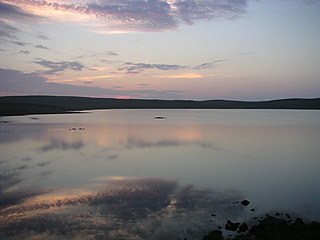
Loch of Isbister is a loch of Whalsay, Shetland Islands, Scotland, located on the northern side of Isbister on the eastern side of the island.
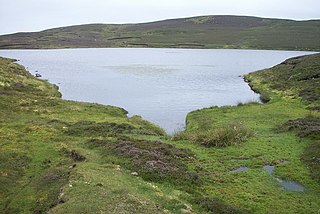
Loch of Livister is a loch of southern-central Whalsay, Shetland Islands, Scotland, located to the north of the Loch of Huxter. Though the Loch of Livister is a much smaller loch than the Loch of Huxter, it has richer biodiversity, with Notonectidae, Coleoptera kotifera, and others.

Loch of Stanefield is a small loch of southern-central Whalsay, Shetland Islands, Scotland. It is located to the northeast of the Loch of Livister, west of Nuckro Water, and east of Little Water.
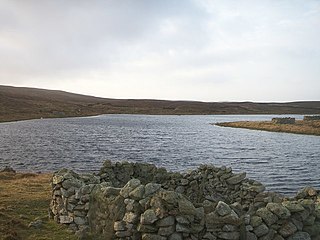
West Loch of Skaw is a loch of northern-central Whalsay, Shetland Islands, Scotland, to the southwest of the village of Skaw, Whalsay.
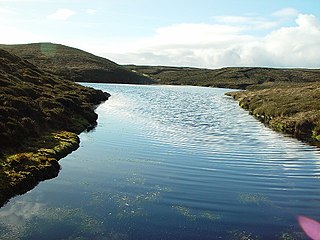
Little Water is a small loch of southern-central Whalsay, Shetland Islands, Scotland. It is located to the north of the Loch of Livister, south of the Loch of Houll, and west of the Loch of Stanefield.
Falsa Burn is a burn (stream) of southeastern Whalsay, Shetland Islands, Scotland. Roughly 600 metres (2,000 ft) in length, it ends near the sea to the south of Treawick, near Falsa Geo. Near the source, across the road from Nuckro Water is an unroofed building, which was probably used as a mill; it was shown on the 1st OS map of Orkney and Shetland in 1882.

Huxter Fort is an Iron Age fortification on the island of Whalsay, in the Shetland islands of Scotland, dating to around 300 BC. It is on an islet in the Loch of Huxter, connected to the shore by a causeway.

Setter Hill is a hill in western Whalsay, Shetland Islands, Scotland. It lies to the southeast of the village of Marrister and northeast of the main village on the island, Symbister. The source of Scarfmoor Burn is on the southeastern side of Setter Hill. On its eastern side is the Loch of Houll. There is an old quarry in the vicinity. Since the spring of 2001, the hill has been part of Shetland's Past Project, a project geared towards encouraging and training individuals to undertake archaeological surveys of their local landscapes in the Shetland Islands.




















